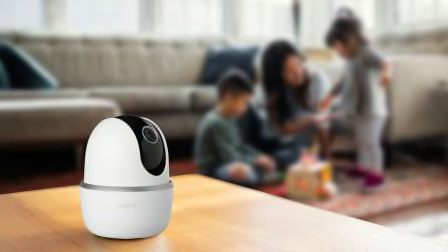Best Baby Monitors of 2025
We tested more than a dozen models from Eufy, Nanit, Owlet, VTech, and more to help you find the ones that don't sacrifice privacy and security
When you shop through retailer links on our site, we may earn affiliate commissions. 100% of the fees we collect are used to support our nonprofit mission. Learn more.

Taking care of a baby is a 24-hour-a-day job, and as you quickly realize, you’re still on duty even when your infant is asleep. That’s where a baby monitor can help. These clever devices—which have become increasingly feature-rich in recent years—offer peace of mind by allowing you to keep tabs on your little one. Wherever you are in your house or apartment, you can check the monitor to get a look at your baby without having to tiptoe to their bedroom door.
Video baby monitors fall into a few broad categories. Video baby monitors transmit sound and visuals to a video receiver unit that you can carry with you from room to room. WiFi video baby monitors send their audio and video feed through the internet to a manufacturer’s servers, then to your smartphone. Some WiFi baby monitors also come with a video receiver unit that you can use without WiFi so that you have the option of using the monitor in offline mode. These are sometimes called hybrid monitors. Each type of baby monitor has its benefits and drawbacks, which we break down below in our top picks.
Best Baby Monitors
Below are the best baby monitors to keep tabs on your little one. For more options, explore our comprehensive baby monitor ratings. For shopping tips, including additional key features to look for, check out our baby monitor buying guide.
These baby monitors range from about $40 to more than $400. But our testers found little correlation between cost and performance. You can get a solid pick for under $100.
Overall Best Baby Monitor
Best WiFi Baby Monitor
Best Local-Only Video Baby Monitor
Best Extra Features
Easiest Setup
Best Budget-Friendly Baby Monitor
Best Basic Baby Monitor
How CR Tests Baby Monitors
In addition to the top picks on this list, we also tested baby monitors from Harbor, Infant Optics, Miku, MomCozy, Nanit, and Owlet.
We started by listing all of each monitor’s features, making note of such details as video quality, volume and notification controls, and noise, temperature, and motion sensors. Then we tested the battery life of each parent unit in our labs and compared it with the claimed life on the box. Finally, we asked our parent testers to use each monitor at home, paying special attention to how easy it was to set up, the stability of the connection—whether via WiFi or local—and the practical experience of using the monitor during naps and overnight.
To evaluate the security of the baby monitors, our testers used the same protocol that we employ for wireless security cameras. We started by evaluating each company’s public documentation, such as privacy policies and terms of service, to see what claims it made about the way it handles customer data. The tests included an inspection of the user interface and network traffic from each camera and its companion smartphone app to make sure it was using encryption, adhering to manufacturer policies, and not sharing data with irrelevant third parties. And we attempted to find security vulnerabilities that cybercriminals could exploit.
Connected vs. Local Display Baby Monitors
Connected baby monitors that use your smartphone display are convenient. If you’re out on a date night, you can check in on your baby directly instead of asking the caregiver for a report.
But monitors with a display of their own have an advantage when it comes to security. The video feed stays local; there’s no way to access it from outside your home. That means the feed is less likely to get hacked, something that has happened from time to time on connected models, though it’s rare. It also prevents a manufacturer from accessing the video and other information that can be gleaned from the device.
Consumer Reports tests baby monitors primarily on ease of use and the quality of the video feed. But we put the internet-connected baby monitors through additional evaluations to look for potential risks. Most of them receive middling marks for security against potential hacking and for privacy (how the companies collect and handle data from the devices).
How to Strengthen Your Baby Monitor’s Security
If you opt for the convenience of a baby monitor with smartphone connectivity, here are some easy steps you can take to make it more secure.
Use a complex password. Some baby monitors allow you to use a six-character password, but our privacy experts urge you to use at least eight characters, with a mix of letters, numbers, and other characters. (See our password manager ratings and buying guide.)
Enable multifactor authentication. This feature should really be standard on any important connected device or online account. MFA can prevent someone who gets your password from logging in to your account. Once you’ve set it up, you’ll also be alerted if someone with your credentials tries to log in from a new device.
Routinely update the device’s firmware. Some baby monitors perform automatic updates, while other models require you to do it manually. If you buy a model without automatic updates, our experts suggest that you check for and perform firmware updates once a month to keep on top of security fixes and enhancements. Many manufacturers will allow opting into product updates without also opting into promotions or third party advertisements. That can be helpful for knowing when security updates are available.
Features to Look For in a Baby Monitor
If you want to learn about what type of baby monitor may be right for your family and how to choose among the different options, see our baby monitor buying guide. In the meantime, here’s a list of the top features that many parents prioritize.
HD screen resolution: Most models have color cameras (and screens, for the non-smartphone models). Resolution ranges from a grainy 320p to a high definition 1080p. Our testers found that while even low-res models were adequate to see what a child was doing, it’s probably worth getting a monitor with high definition.
Two-way talk: Most baby monitors feature two-way communication, which allows you to hear a baby’s noises and talk back. Some models can even play music or sounds.
Multiple cameras with split-screen display: Most baby monitor manufacturers will sell you additional cameras that can feed the same display, which can be useful if you have more than one small child. If you’d like to be able to see multiple children at once, look for a model that offers split-screen displays.
Temperature sensors: While most modern baby monitors report on the temperature in the child’s room, some also add a humidity reading, which might be useful, say, if you’re running a humidifier or a vaporizer in a sick child’s room.
Volume control: For monitors that transmit to a separate receiver, it’s helpful to have easy access to its volume control. Our testers note that a physical control is much easier to use than a menu that you access by toggling through multiple screens.
For smartphone monitors, you want to be sure that you can still hear the live feed even if you’re not actively in the app. That way, you can use your phone while monitoring your child.
Notifications: Many WiFi monitors that connect to a smartphone through an app offer a variety of notification options. For example, some models can distinguish between a cough and a cry, and allow you to select whether you want to receive notifications for both, just one, or none. Our testers appreciated monitors that had specific notification settings because they reduce the likelihood of false alerts but don’t miss when your baby needs soothing.
Most video baby monitors with stand-alone receivers will notify you with lights that turn on when your baby makes a sound. As your child cries more loudly, the warning lights get brighter. This is helpful if you’ve placed the receiver in a noisy room or if you’ve turned the volume down.
Night vision: Most baby monitors have a night vision feature, using an infrared setting on the camera so that you can see your baby on the monitor in a dark room.
Out-of-range indicator: This feature lets you know that you’ve reached the monitor’s range limit, which can vary according to your home’s size, construction materials, and other factors.
For additional features you may want, plus our shopping tips, see our baby monitor buying guide.
A Note on Health Tracking Features in Baby Monitors
A growing number of baby monitors now offer health tracking features that purport to monitor various health metrics, such as heart rate, oxygen saturation, breathing rate, sleep quality, and body temperature. While it’s understandable to want to keep a close eye on your baby’s health and well-being, both the American Academic of Pediatrics and the Food and Drug Administration warn that these devices haven’t been proved to prevent sudden infant death syndrome and haven’t been reviewed or cleared as medical devices. At Consumer Reports, we advise parents to talk with their pediatrician before using infant health tracking devices to be sure that they have one that suits their baby’s needs.
Consumer Reports doesn’t evaluate health tracking functions in the baby monitors we test. But in our baby monitor ratings, we note whether a model offers those features, such as breathing detection.
What’s the Safest Way to Install a Baby Monitor?
Your monitor will come with instructions for a safe setup, but there are a few foundational guidelines you should follow.
- Never put a baby monitor in a baby’s crib or mount it on the crib rails.
- Never put a baby monitor on a shelf or stand, where it’s likely to fall.
- Make sure electrical cords are at least 3 feet away from the crib.
Some baby monitors come with a plastic conduit to help secure the cord. Keep in mind that babies develop fast. Before you know it, your tiny newborn will be rolling over, pulling up, and grasping at anything within reach. Be sure to keep the monitor camera, along with its cords, stand, and any other accessories a safe distance from the crib.





















